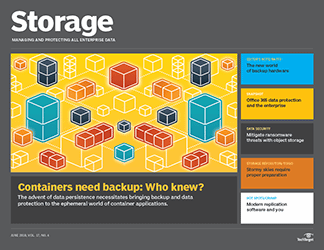PRO+ Premium Content/Storage
Access your Pro+ Content below.
A data replication strategy for all your disaster recovery needs

This article is part of the Storage issue of June 2018, Vol. 17, No. 4
Meeting an organization's disaster recovery challenges requires addressing problems from several angles based on specific recovery point and recovery time objectives. Today's tight RTO and RPO expectations mean almost no data gets lost and no downtime. To meet those expectations, businesses must move beyond backup and consider a data replication strategy. Modern replication products offer more than just a rapid disaster recovery copy of data, though. They can help with cloud migration, using the cloud as a DR site and even solving copy data challenges. Replication software comes in two forms. One is integrated into a storage system, and the other is bought separately. Both have their strengths and weaknesses. An integrated data replication strategy The integrated form of replication has a few advantages. It's often bundled at no charge or is relatively inexpensive. Of course, nothing in life is really free. The customer pays extra for the storage hardware in order to get the "free" software. In addition, at-scale, storage-based ...
Features in this issue
-
Container backup follows data persistence to these ephemeral apps
The advent of data persistence in containers necessitates having data backup in containers. Here's how this is being done and which vendors are leading the way.
-
Office 365 data protection, the enterprise and you
Gain a better understanding of Microsoft Office 365 security and storage management features and how the popular cloud-based productivity and collaboration suite really works.
Columns in this issue
-
What's new with data protection systems? Everything
The next backup hardware you purchase will likely come with integrated backup software. That changes the buying dynamic and complicates the decision-making process.
-
Disaster avoidance requirements ensure business continuity
Include disaster recovery and avoidance requirements as design goals when creating storage and production environments to ensure business continuity during weather events.
